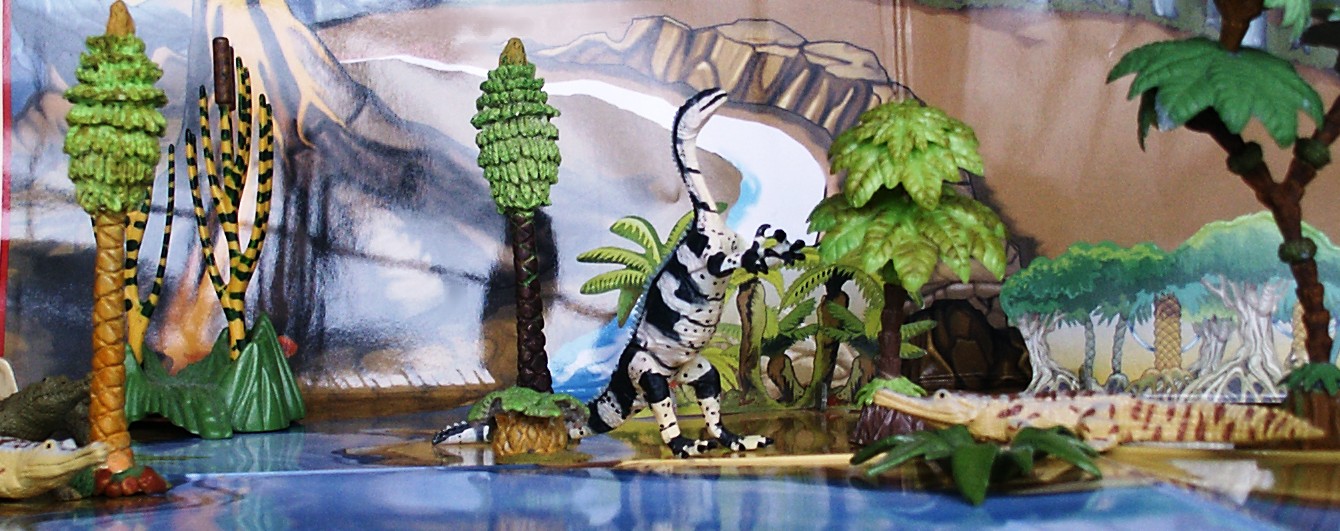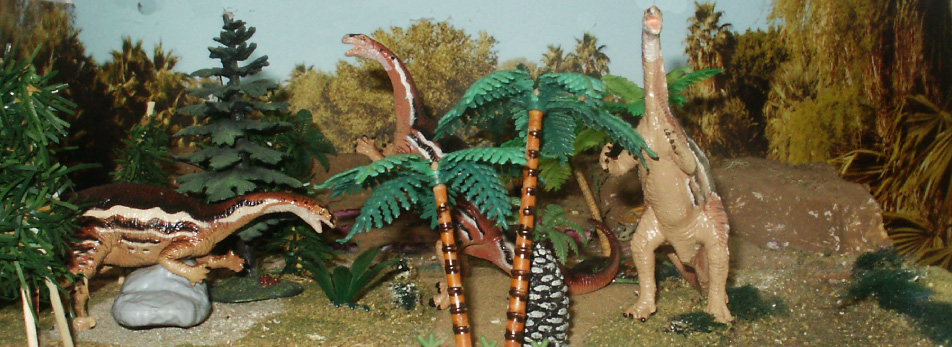Late Traissic Rhaetian
The last stage of of the Late Triassic 203 to199 million years ago. The world continent, Pangea, is still mostly intact but Gondwanaland and Laurasia are just starting break away from each other. Both flora are fauna are similar around the world indicating that no barriers existed to isolate populations.
updated 110412

In the Late Triassic and Early Jurassic cycadoids or bennettities are the characteristic plants and prosauropods are the characteristic animals. Generally medium to low in height they are thought to be slow growing with foliage high in toxins and generally of low food value. Superficially cycadoids resemble cycads which become more common later in the Jurassic declining in the Cretaceous but still surviving today. Some are slender with branching trunks vaguely palm like while others look like pinecone with leaves on top. Older Paleozoic flora like the giant club Moss and horsetails still are present in wet areas but they steadily decline and primitive conifers and ferns are present. The world continent Pangea is still mostly intact. Gondwanaland and Laurasia are just starting break away. Both flora are fauna are similar around the world indicating that no barriers existed to isolate populations. Prosauropods are the most common dinosaurs from latest Triassic to the end of the Early Jurassic. prosauropods and stegosaurs have the distinction of being the only major groups to die out before the end of the mesozoic. The climate is arid relieved only by megamonsoons. The environment was alternately baked then flooded. The Plateosaurus and Coelophysis bone beds from this time are thought to be the result of flash floods.
 Prosauropods were
once seen as the ancestors of the giant sauropods of the Late Jurassic but
recent finds of sauropods in Thailand and South Africa show sauropods present in
the Late Triassic. The finds are scrappy and rare but they seem to
indicate large animals with bony nodules for armor. While many of the larger Prosauropods were bipedal the newly hatched ran around on four feet moving to two as they developed.
Prosauropods were
once seen as the ancestors of the giant sauropods of the Late Jurassic but
recent finds of sauropods in Thailand and South Africa show sauropods present in
the Late Triassic. The finds are scrappy and rare but they seem to
indicate large animals with bony nodules for armor. While many of the larger Prosauropods were bipedal the newly hatched ran around on four feet moving to two as they developed.
 Plateosaurus was one of the largest herbivores of its time at 27 feet. There were
numerous similar looking prosauropods the 6 1/2-foot Anchisaurus , the 30-foot Euskelosaurus and the 13-foot Massospondylus. Prosauropods show up in the fossil record as fairly large animals in the Carian and are supposed to have evolved from smaller animals. The are the
most common large animals for 50 million years. They are best known as the
only family besides the stegosaurs to become extinct before the end of the
Mesozoic. They don't get much attention. They diversify and evolve
many smaller forms like Anchisaurus and larger animals similar to the sauropods.
Plateosaurus was one of the largest herbivores of its time at 27 feet. There were
numerous similar looking prosauropods the 6 1/2-foot Anchisaurus , the 30-foot Euskelosaurus and the 13-foot Massospondylus. Prosauropods show up in the fossil record as fairly large animals in the Carian and are supposed to have evolved from smaller animals. The are the
most common large animals for 50 million years. They are best known as the
only family besides the stegosaurs to become extinct before the end of the
Mesozoic. They don't get much attention. They diversify and evolve
many smaller forms like Anchisaurus and larger animals similar to the sauropods.
 Prosauropods and coelphysids are the
most common dinosaurs from last of the Late Triassic to the end of the Early Jurassic. Prosauropods and stegosaurs have the distinction of being the only major groups to die out before the end of the mesozoic. The
climate is arid relieved only by megamonsoons, oxygen levels drop and the may have been a strike from space at the end of the Triassic. The environment was
alternately baked then flooded. Low oxygen levels may have favored the avian style lung system of the dinosaurs. Low oxygen would have caused confiers to grow faster and high but reduced their food value. Both would have favored large herbivores like prosaurpods and sauropods.
Prosauropods and coelphysids are the
most common dinosaurs from last of the Late Triassic to the end of the Early Jurassic. Prosauropods and stegosaurs have the distinction of being the only major groups to die out before the end of the mesozoic. The
climate is arid relieved only by megamonsoons, oxygen levels drop and the may have been a strike from space at the end of the Triassic. The environment was
alternately baked then flooded. Low oxygen levels may have favored the avian style lung system of the dinosaurs. Low oxygen would have caused confiers to grow faster and high but reduced their food value. Both would have favored large herbivores like prosaurpods and sauropods.
